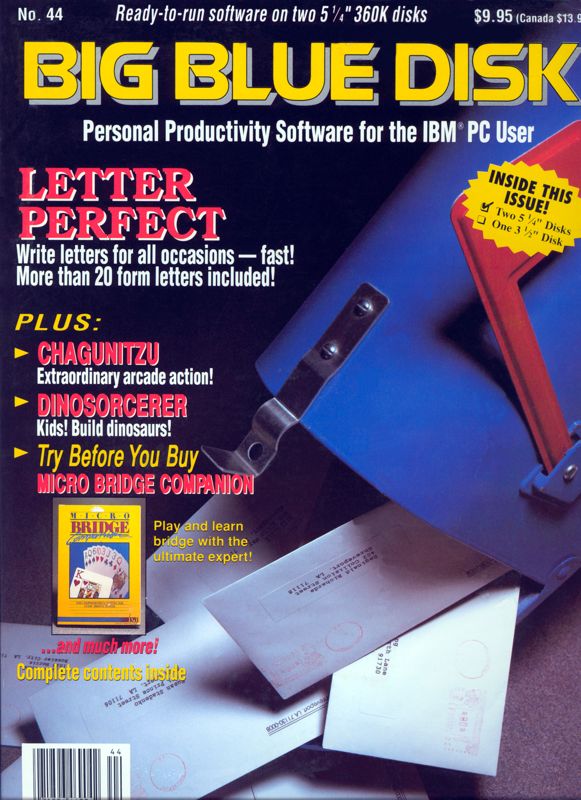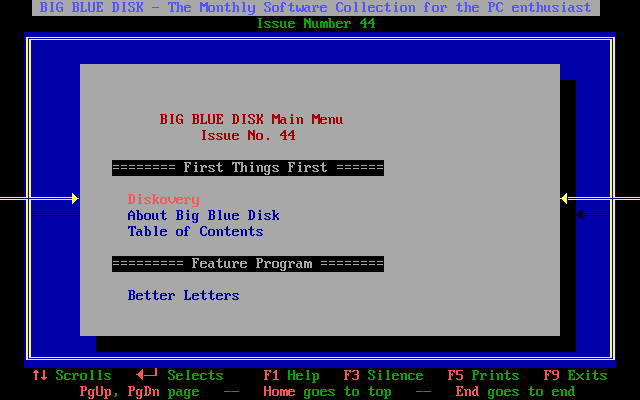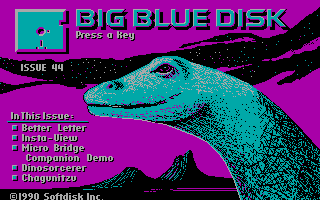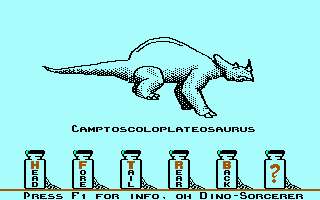Retro Replay Review
Gameplay
Big Blue Disk #44 showcases a diverse array of software experiences, anchored by its sole full-version game, Chagunitzu. As the precursor to the beloved Paganitzu, Chagunitzu offers an engaging blend of action and puzzle mechanics. Players navigate a maze-like environment, collecting keys and avoiding hazards while unlocking doors to progress. The learning curve is gentle yet rewarding, making it accessible for newcomers and series veterans alike.
(HEY YOU!! We hope you enjoy! We try not to run ads. So basically, this is a very expensive hobby running this site. Please consider joining us for updates, forums, and more. Network w/ us to make some cash or friends while retro gaming, and you can win some free retro games for posting. Okay, carry on 👍)
Beyond Chagunitzu, the issue includes Dino-Sorcerer, a whimsical program that randomly generates dinosaur illustrations. While not a traditional game, Dino-Sorcerer’s simple point-and-click interface encourages experimentation and creative delight. Every click yields a new prehistoric beast, ensuring that users remain entertained through the seemingly endless permutations of scales, horns, and tails.
Fans of card games will appreciate the demo version of Micro Bridge Companion. Though limited in scope compared to the full release, it provides a solid introduction to competitive bridge play. The AI opponents demonstrate varied strategies, and the user interface streamlines bidding and trick-taking. This demo is an excellent appetizer for those curious about deeper card-game software.
All of these offerings are accessed through a straightforward, text-based menu system. While lacking in graphical flourish, the menu’s clarity ensures quick access to each program. This approach underscores the disk’s focus on substance over style, allowing players to dive into their chosen application without navigating convoluted submenus.
Graphics
Chagunitzu’s graphics reflect the aesthetic conventions of early DOS-era titles. The tile-based environments are rendered in a limited color palette, yet each area remains distinct and recognizable. Character sprites are small but well–designed, conveying movement and action with minimal frames. Although primitive by modern standards, the visuals possess a nostalgic charm that veteran gamers will appreciate.
Dino-Sorcerer stands out graphically for its procedural creativity. Each dinosaur silhouette appears slightly different, showcasing a clever mix of predefined assets. The program’s ability to generate countless unique creatures from a small library of parts speaks to the ingenuity of early graphical programming. Users will find themselves clicking again and again to see what freakish or fascinating dinosaur emerges next.
The Micro Bridge Companion demo opts for a clean, paper-like aesthetic. The virtual card table, crisp card faces, and simple scoreboard graphics prioritize readability over ornamentation. While there are no flashy animations, the interface conveys essential information at a glance, ensuring that players stay focused on strategy rather than visual distractions.
The disk’s menu system, though entirely text-based, integrates neatly with the graphical applications. Menu options are presented with clear prompts, and file listings are easy to scan. For an era when graphical loaders were still maturing, this utilitarian design means faster load times and fewer memory conflicts, enhancing overall stability.
Story
Chagunitzu offers a light narrative framework that sets the stage for its puzzle–action gameplay. You assume the role of an adventurer exploring ancient temples, seeking hidden treasures while outwitting traps and guardians. Although the storyline is sparse, each level’s thematic decor—from torchlit corridors to booby-trapped chambers—reinforces the sense of exploration and discovery.
The other components of Big Blue Disk #44 are primarily utility or entertainment programs, and thus they carry little in the way of narrative. Dino-Sorcerer speaks through images rather than words, letting the user’s imagination fill in the dinosaur bios. The Micro Bridge Companion demo and Harpoon review focus on functionality and critique, respectively, without weaving a fictional tapestry.
However, the text-based menu system itself creates a cohesive experience. By presenting each item as part of a curated collection, the disk feels like an interactive magazine rather than a random assortment of files. This editorial framing lends an undercurrent of continuity, encouraging users to sample every offering as though flipping through themed sections of a digital periodical.
Overall, while Big Blue Disk #44 does not boast a unified storyline, the individual components blend gameplay objectives, creative tools, and informative content into a well–rounded package. The lightly scripted adventure of Chagunitzu provides enough narrative drive, while the ancillary items enrich the overall sense of discovery.
Overall Experience
Big Blue Disk #44 exemplifies the charm and practicality of early subscription-based software distribution. For subscribers, receiving a monthly disk brimming with a full game, utilities, demos, and articles felt like opening a digital treasure chest. The inclusion of Chagunitzu as a full-version title represents excellent value, while the additional items ensure there’s something for every interest.
Although modern gamers may find the text-based menu and pixel-low graphics archaic, these features are part of the disk’s retro appeal. The straightforward interface minimizes technical hurdles, and the variety of content encourages exploration. Whether you’re in the mood for action-puzzle challenges, random dinosaur art, strategic card play, or even planning naval engagements in the Harpoon review, this issue delivers.
Stability and compatibility are notable assets as well. Big Blue Disk #44 runs reliably on period-accurate hardware, and the small file sizes mean quick loading even on floppy drives. For collectors and enthusiasts of DOS software, this issue offers a hassle-free opportunity to experience classic titles exactly as they were released.
In summary, Big Blue Disk #44 remains a compelling snapshot of early ’90s PC gaming culture. It balances a standout full-version game with lighthearted extras, all packaged within an intuitive menu-driven interface. For retro gaming fans or newcomers curious about the roots of action–puzzle design, this disk is well worth a spot in your digital library.
 Retro Replay Retro Replay gaming reviews, news, emulation, geek stuff and more!
Retro Replay Retro Replay gaming reviews, news, emulation, geek stuff and more!







Reviews
There are no reviews yet.